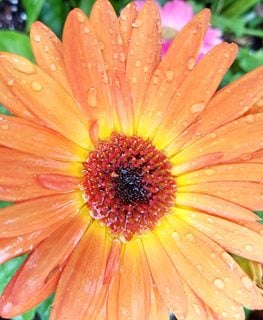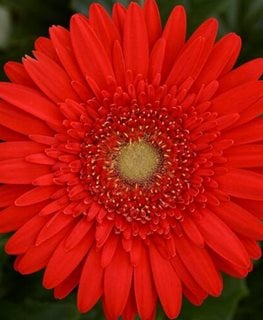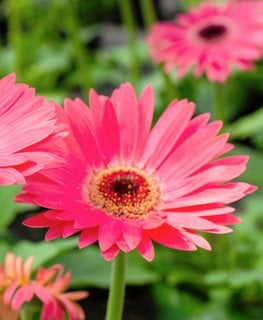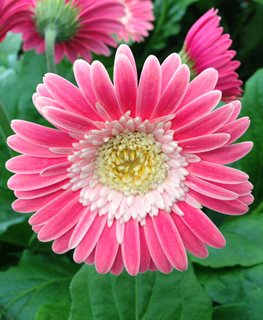Grow Gorgeous Gerbera Daisy Flowers in Your Garden
Tips for planting, caring for, and using with these bright and cheerful summer flowers.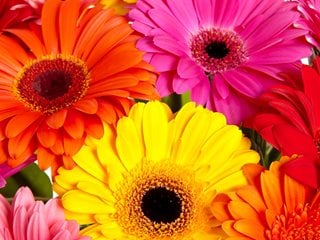
Photo by: Smetana Natasha / Shutterstock
Even if you’ve never grown gerbera daisy plants in your garden, chances are you’ve enjoyed gerbera daisies indoors in cut flower arrangements and bouquets. With their large upturned flowers, vibrant colors, and long stems, gerbera daisies have earned their status as one of most popular cut flowers in the world.
Native to South Africa, gerbera daisies are tender perennials that can be grown outdoors as annuals in almost any climate. You’ll commonly find gerbera plants sold at garden centers in the spring, or you can buy a pack or two of seeds in the flower color and variety of your choice. With proper planting and a little attention, either option will bring bold splashes of color to your garden beds and containers all summer long.
On this page: Basics | Growing Tips | Care and Maintenance | Pictures | Design Ideas
On this page:
- BASICS
- GROWING GERBERA DAISIES
- GERBERA DAISY CARE AND MAINTENANCE
- GERBERA DAISY PICTURES
- DESIGN IDEAS
BASICS
Botanical name:
Gerbera jamesonii
Common names:
Gerbera daisy, African daisy, Transvaal daisy, Barberton daisy
Hardiness Zones:
8-11, usually grown as an annual
Height:
When grown as a annual, plants reach a maximum height of about 12 inches. When grown as a perennial, stems can reach up to 3 feet high.
Exposure:
Partial to full sun
Bloom time:
Late spring through fall; blooms last for several weeks
Flowers:
The petals come in almost every color, from soft pastels to zesty shades of orange and red. The center floral disk also varies and may match or contrast the petals. Flower heads range from 2 to 6 inches across and come in a variety of forms including single, semi-double, double, and crested double.
Foliage:
Slender, lobed, dark green leaves form basal rosettes, with the flowers rising above them on long, leafless stems.
GROWING GERBERA DAISIES
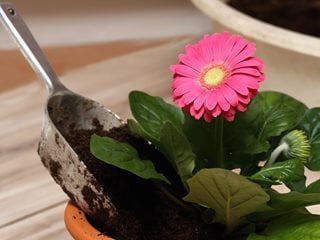
Photo by: Iva / Shutterstock.
When to plant:
In late spring, after the danger of frost has passed.
Where to plant:
Gerberas grow best in areas that receive plenty of sunlight (at least 6 hours a day), but they don’t like intense heat. In warmer climates, plant them in a spot that provides some afternoon shade.
Soil:
Plant in compost-rich, well-drained, slightly acidic soil (pH of 5.5 to 6.5). Good soil drainage is important to avoid crown and root rot. If you have heavy clay soil, consider growing your gerberas in containers with a high-quaility potting mix.
Growing from starter plants:
Space plants 12 to 18 inches apart to ensure good air flow, and place the crowns slightly above soil level to avoid crown rot. Water regularly until plants become well established, keeping the soil evenly moist but not soggy. Apply a layer of organic mulch around your plants to help conserve soil moisture, but be careful not to cover the crowns.
Growing from seed:
Although it’s more convenient to grow them from plant starts, growing gerbera daisies from seed allows you to choose from a wider array of varieties and color combinations. Sow seeds directly in the garden after the soil has warmed in the spring, but you’ll enjoy blooms much sooner if you start the seeds indoors 12 to 18 weeks before the last frost.
The seeds need light for germination, so just press them lightly into the soil surface. Transplant the seedlings outdoors when they have at least two sets of leaves. Depending on growing conditions, the first blooms will appear 18 to 24 weeks after sowing.
GERBERA DAISY CARE AND MAINTENANCE
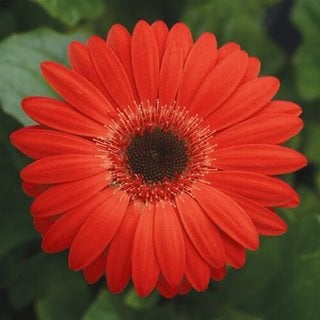
Revolution™ Red Dark Eye Gerbera Daisy (Gerbera jamesonii)
Photo by: Proven Winners
Watering:
Once established, water the plants when the surface of the soil feels dry to the touch, but be careful not to oversaturate the soil, which can lead to crown and root rot. To discourage powdery mildew and other foliar diseases, avoid overhead watering or water early in the day so the leaves have a chance to dry before nighttime.
Fertilizing:
To keep your gerberas flowering vigorously all season, feed them with a water-soluble fertilizer every two weeks or with a slow-release granular plant food applied several times during the growing season. Potted plants may need more frequent feedings.
Pruning and deadheading:
To encourage optimal flowering, remove spent blooms as soon as they fade, cutting the stalks back to the base of the plant. Also keep your plant tidy by removing withered or damaged leaves.
Because the flower production of a gerbera relies on sunlight reaching the crown, where the buds form, it’s also a good idea to prune away any excess foliage that inhibits light penetration to the center of the plant.
Propagating:
Gerberas tend to be short-lived, but the plants are easy to propagate by dividing them in the spring or fall or by taking stem cuttings after your plants finish flowering. Unless you plan to let your plants self-sow, divide them every two or three years to extend their lifespan.
Winter protection:
In zones 8 and above, you can grow gerbera daisies successfully as perennials if you protect your plants from freezing temperatures.
In colder climates, bring container-grown gerberas indoors over winter and store in a location that receives bright light and cool temperatures (45 to 50 degrees F). Allow plants to enter a period of dormancy by watering sparingly and reducing fertilization.
Another option is to grow your gerbera as a houseplant by placing it in a warm room (about 70 degrees F) in a location that receives bright, indirect sunlight. Don’t worry if your plant only blooms sporadically or not at all during the winter. It will resume flowering in the spring.
Pests and problems:
No serious insect or disease problems, but may occasionally be bothered by whiteflies, aphids, thrips, and spider mites.
Also watch out for chlorosis, or yellowing of the leaves, which can occur if plants are grown in highly alkaline soil.
GERBERA DAISY PICTURES
DESIGN IDEAS
Use Gerbera daisies in annual garden beds and borders and in containers, either alone or mixed with other sun-loving annuals and perennials.
Also a good addition to cutting gardens, cottage gardens, and butterfly gardens.
RELATED:
21 Easy Flowers
How to Start a Flower Garden
12 Summer Flowers
